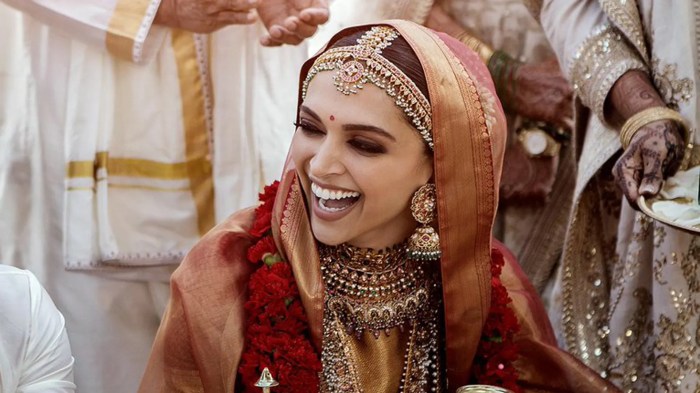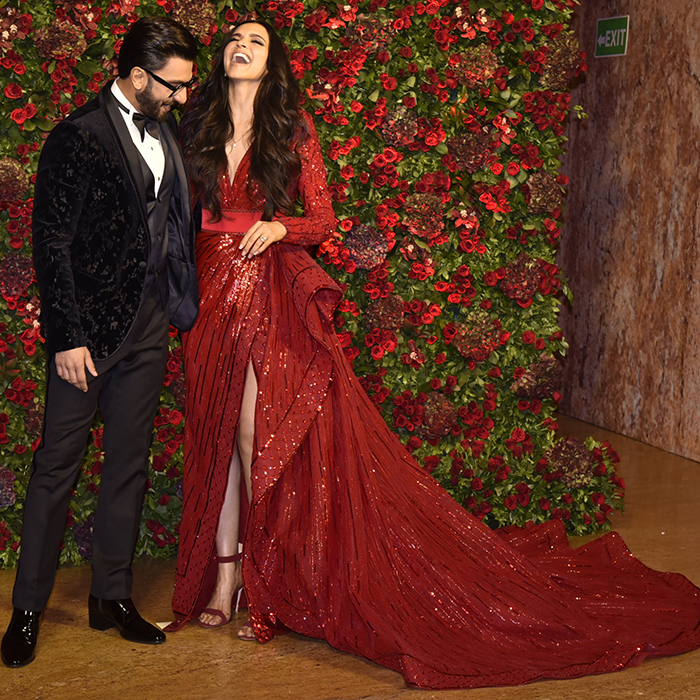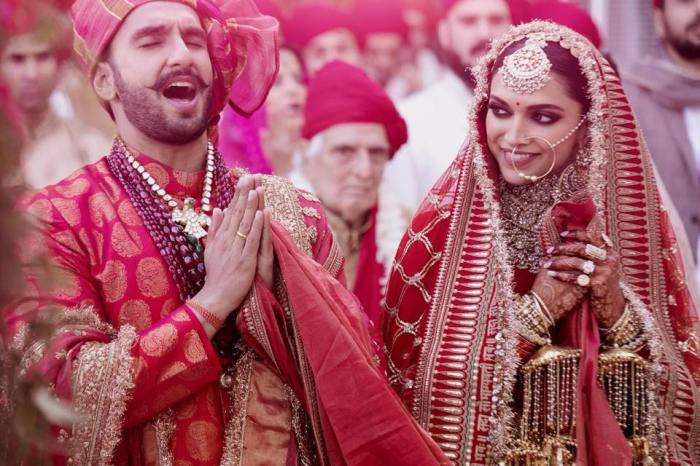Deepika Padukone’s Wedding Saree: A Timeless Icon: Deepika Padukone Wedding Dress

Source: vogue.in
Deepika padukone wedding dress – Deepika Padukone’s wedding attire, a stunning Kanjeevaram silk saree, remains a significant moment in Indian bridal fashion. Its exquisite design, cultural symbolism, and enduring impact continue to inspire designers and brides alike. This article delves into the details of the saree, exploring its design elements, cultural influences, and lasting legacy.
Deepika Padukone’s Wedding Attire: A Detailed Description

Source: vogue.in
Deepika Padukone’s wedding saree showcased a traditional Kanjeevaram silk design, characterized by its rich, vibrant colors and intricate gold zari embroidery. The saree featured a classic silhouette, draped elegantly to accentuate her figure. The pallu (the decorative end of the saree) was particularly elaborate, showcasing dense embroidery and a captivating border.
The embroidery incorporated traditional South Indian techniques like “kora” work (fine gold threads) and “butta” motifs (small, repeating patterns). These were meticulously crafted, creating a luxurious and visually stunning effect. The saree’s color palette, a deep, rich red, is a traditional choice for Indian brides, symbolizing prosperity, good fortune, and marital bliss. The color choice also subtly echoed the traditional South Indian bridal aesthetic.
A similar saree could be created using different fabrics, such as a luxurious Banarasi silk or a lightweight, contemporary silk blend. The embellishments could be adapted to incorporate modern elements while maintaining the overall aesthetic. For instance, instead of traditional gold zari, one could incorporate delicate silver embroidery or even subtle gemstone accents. The color palette could be adapted to include more contemporary shades, perhaps a deep burgundy or a rich maroon, while still retaining the significance of a rich, saturated hue.
The Designer and its Significance
Deepika Padukone’s wedding saree was designed by Sabyasachi Mukherjee, a renowned Indian designer known for his opulent and culturally rich designs. His design philosophy blends traditional Indian craftsmanship with contemporary aesthetics, creating pieces that are both timeless and modern.
Sabyasachi has a long-standing reputation for creating exquisite bridal wear and his designs are frequently seen on high-profile clients. His work often features intricate embroidery, rich fabrics, and a deep understanding of Indian textile traditions. He consistently showcases a blend of classic and modern elements, making his designs both elegant and relevant.
Comparing Deepika’s saree to other Sabyasachi creations reveals a consistent thread of traditional techniques and opulent embellishments. While each design is unique, they share a common aesthetic of refined elegance and cultural richness.
| Saree Details | Year | Notable Features | Inspiration |
|---|---|---|---|
| Deepika Padukone’s Wedding Saree | 2018 | Intricate gold zari embroidery, deep red Kanjeevaram silk | Traditional South Indian bridal wear |
| Anushka Sharma’s Wedding Lehenga | 2017 | Muted pink and gold, intricate embroidery, traditional silhouettes | Classic Rajasthani bridal aesthetics |
| Priyanka Chopra’s Reception Gown | 2018 | Red and gold embroidered gown, fusion of Indian and Western elements | A blend of traditional and contemporary aesthetics |
Cultural and Traditional Influences
Deepika Padukone’s saree is deeply rooted in South Indian wedding traditions. The choice of Kanjeevaram silk, a renowned South Indian textile, and the use of traditional embroidery techniques, directly reflect this cultural influence. The deep red color, as previously mentioned, holds significant symbolism in Indian weddings.
Deepika Padukone’s wedding ensemble was a stunning example of traditional elegance. Achieving the perfect silhouette for such an important occasion often involves careful consideration of undergarments, and many brides find that using bra inserts for wedding dress can significantly enhance the fit and overall look. This detail, while subtle, contributes to the overall impact of the final bridal look, much like the careful craftsmanship evident in Deepika’s own iconic wedding attire.
The “butta” motifs and the overall design language are also reflective of traditional South Indian aesthetics. While the saree has a distinctly South Indian character, elements of broader Indian bridal traditions are also present in its opulence and the use of gold zari.
Compared to traditional wedding attire from other regions, Deepika’s saree stands out with its distinct South Indian character. For instance, a Bengali bride might wear a red and gold Banarasi saree, while a Punjabi bride might opt for a richly embroidered lehenga. Each region boasts its own unique bridal style, reflecting diverse cultural influences.
- Deep Red Color: Symbolizes prosperity, good fortune, and marital bliss.
- Kanjeevaram Silk: Represents luxury, tradition, and high quality.
- Gold Zari Embroidery: Signifies wealth, status, and auspiciousness.
- “Butta” Motifs: Traditional South Indian patterns that add intricate detail.
- Classic Drape: Represents elegance, grace, and respect for tradition.
The Impact and Legacy of the Wedding Dress, Deepika padukone wedding dress

Source: scoopnow.com
Deepika Padukone’s wedding saree received widespread media coverage and generated significant public interest. The saree’s popularity was driven by its exquisite design, Deepika’s celebrity status, and the enduring appeal of traditional Indian bridal wear. The saree’s influence on subsequent wedding fashion trends is undeniable. It sparked renewed interest in Kanjeevaram silk and traditional South Indian bridal aesthetics.
Many designers have since incorporated elements of Deepika’s saree into their own collections, reflecting its lasting impact on bridal fashion. Brides have also been inspired to choose similar styles and color palettes for their own weddings, demonstrating the saree’s enduring appeal.
The saree’s lasting impact on the fashion industry can be seen in the following timeline:
- 2018: Deepika Padukone’s wedding; widespread media coverage and public fascination.
- 2019-2020: Increased demand for Kanjeevaram silk sarees and similar designs.
- 2021-Present: Continued influence on bridal fashion, with designers incorporating elements of Deepika’s saree into their collections.
Illustrative Description of the Saree
Deepika Padukone’s wedding saree was a vision of opulent elegance. The deep, crimson red of the Kanjeevaram silk possessed a lustrous sheen, catching the light with every movement. The texture was luxuriously smooth against the skin, while the intricate gold zari embroidery provided a captivating tactile experience. The saree’s color evoked a sense of warmth, joy, and traditional richness.
The overall mood conveyed by the saree was one of timeless sophistication and classic beauty. The intricate craftsmanship, evident in the meticulous embroidery and the flawless drape, highlighted the artistry involved in its creation. The saree’s rich color and detailed embellishments were perfectly complemented by Deepika’s radiant beauty, the garment enhancing her natural grace and elegance. The saree seemed to move with her, its luxurious fabric flowing around her figure in a symphony of movement and light.
Helpful Answers
What type of silk was used in Deepika Padukone’s wedding saree?
While the exact type isn’t publicly known, it’s widely believed to be a luxurious silk, possibly Kanjeevaram or a similar high-quality variety.
Who styled Deepika Padukone for her wedding?
The stylist for Deepika Padukone’s wedding is not consistently reported in major sources, further research may be needed.
What was the approximate cost of Deepika Padukone’s wedding saree?
The exact cost remains undisclosed and is likely confidential due to the nature of high-end bespoke garments.
Where can I find a similar saree to Deepika Padukone’s?
While replicating the exact saree is difficult, many designers offer similar styles in terms of silhouette, embroidery, and color palettes. Searching for “Kanjeevaram silk sarees” or “South Indian bridal sarees” might yield comparable options.
